



The Irish Traditional Music Archive (ITMA) is committed to providing free, universal access to the rich cultural tradition of Irish music, song and dance. If you’re able, we’d love for you to consider a donation. Any level of support will help us preserve and grow this tradition for future generations.
Denis Murphy’s reels come from a variety of sources, allowing for some interesting connections and discoveries. Most of the reels Murphy played for Breandán Breathnach fall under three categories: tunes learned from Pádraig O’Keeffe, tunes from other Sliabh Luachra musicians and tunes from Irish-American sources, such as those from his time in New York. Some 80 CICD cards feature reels transcribed from Murphy’s playing.
Denis Murphy was also well-versed in the popular US-made records of Sligo fiddle players (Michael Coleman, James Morrison, Paddy Killoran etc.) and could quickly pick up the tunes from other musicians in his travels. These sources were not the focus of the recording sessions with Breathnach, who prioritised previously unpublished tunes and rare settings, of which Sliabh Luachra musicians had plenty to offer.
By all accounts, Denis Murphy was fond of playing reels. In general, contrary to the stereotypes now attached to Sliabh Luachra, prominent musicians from the area enjoyed playing reels as much as they did other tunes. Anecdotal evidence suggests that before the local Polka Set became codified during the set-dancing revival, its variants sometimes contained a reel figure, making it one of the most “diverse” sets in Ireland.
By the late 1980s, reels were rarely heard at the local public dancing events such as those taking place in Dan Connell’s Bar in Knocknagree although the musicians had no trouble playing them in sessions at the same spot (even if in different proportions compared to Clare or Sligo). The Breathnach materials help highlight the older local repertoire of reels that is now being rediscovered and celebrated by the new generation of Sliabh Luachra musicians.
Breathnach published his first transcriptions of Denis Murphy’s playing in the journal Ceol vol. 2, no. 4, fresh off recording him in Lisheen in October 1966. Some of these tunes would later appear in Ceol Rince na hÉireann (CRÉ) 2 but not all of the details were included in the influential collection.
Dónal a’ Clumper’s reel (CICD 5267; CRÉ 2, # 295) is an example of this: the title, which Breathnach’s footnote in Ceol says comes from the name of an “itinerant piper”, never made it to CRÉ, where the tune appears untitled.
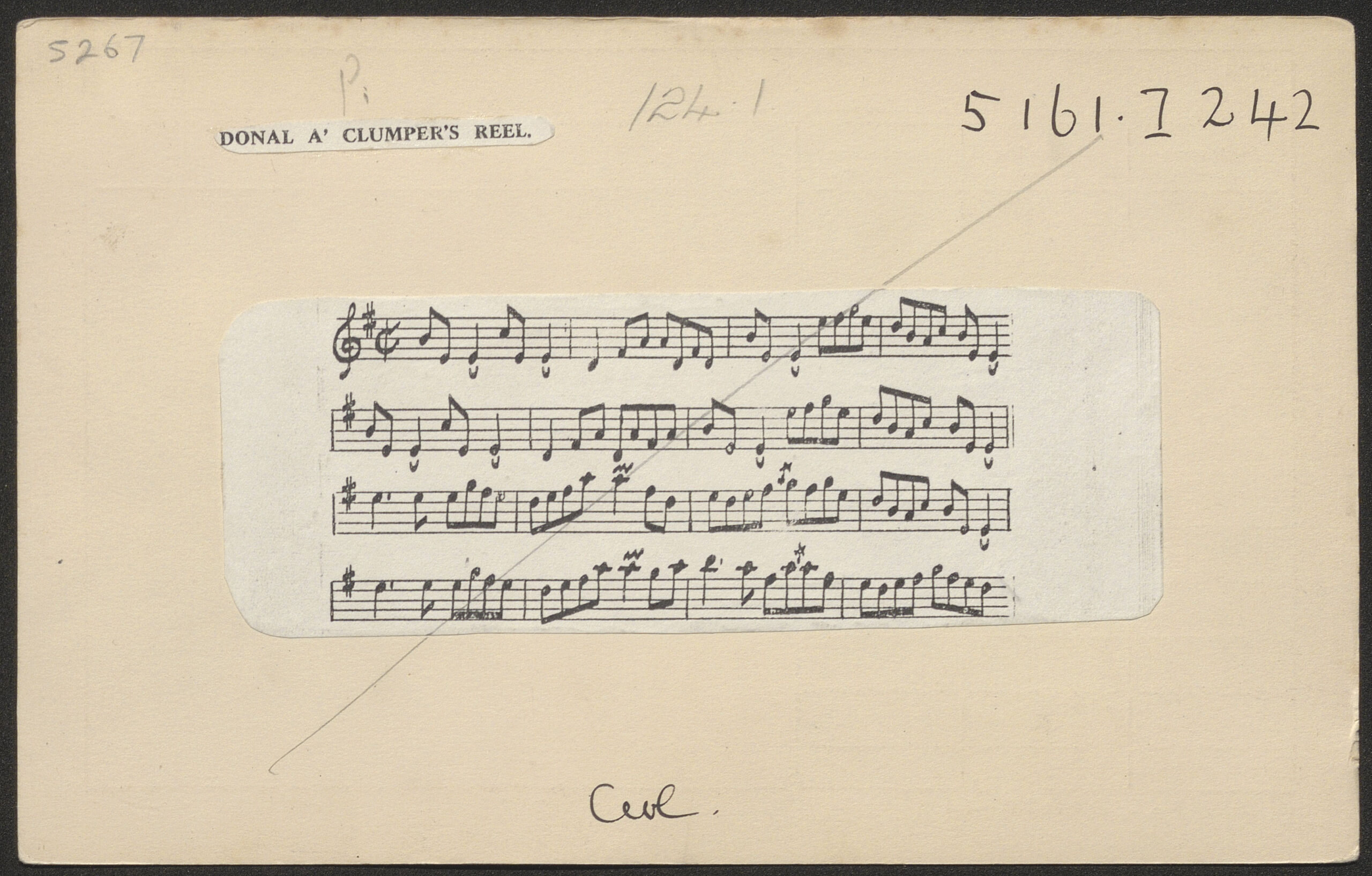
Ceol and CRÉ demonstrate how Breathnach’s understanding of the Sliabh Luachra music and his terminology evolved over time: the 1966 journal called polkas “single reels” or “polka reels” and slides were all titled as “single [jigs]”; the terms were changed in the later publications. The missing title for Dónal a’ Clumper’s could also be a case of later corrections but Denis Murphy’s setting of the tune, which bears similarities to such reels as Patsy Touhey’s, The girls of Farranfore, The humours of Castlefin and The humours of Ballinacarrig, does not have any other unique titles, making it an interesting find.
Denis Murphy gave Breathnach a few unique regional versions of popular reels, some of which were also published in Ceol Rince na hÉireann. Breathnach’s notes on CICD cards reveal Murphy’s sources for these tunes. We learn that the flowery version of The rising sun (CICD 2982; CRÉ 2, # 214) that has become associated with Sliabh Luachra came from the blind fiddle master Tom Billy Murphy (1879–1944); Denis learned it from Pádraig O’Keeffe’s manuscript and played for Breathnach in 1966. On the other hand, Bill O’Keeffe’s reel (CICD 5120) came from O’Keeffe’s brother Bill; Murphy and Breathnach discuss how it is apparently a setting of Jenny picking cockles in the source recording from November 1967. The latter reel also appears to share the second part with such tunes as The glorious return to Milltown and Gorman’s.
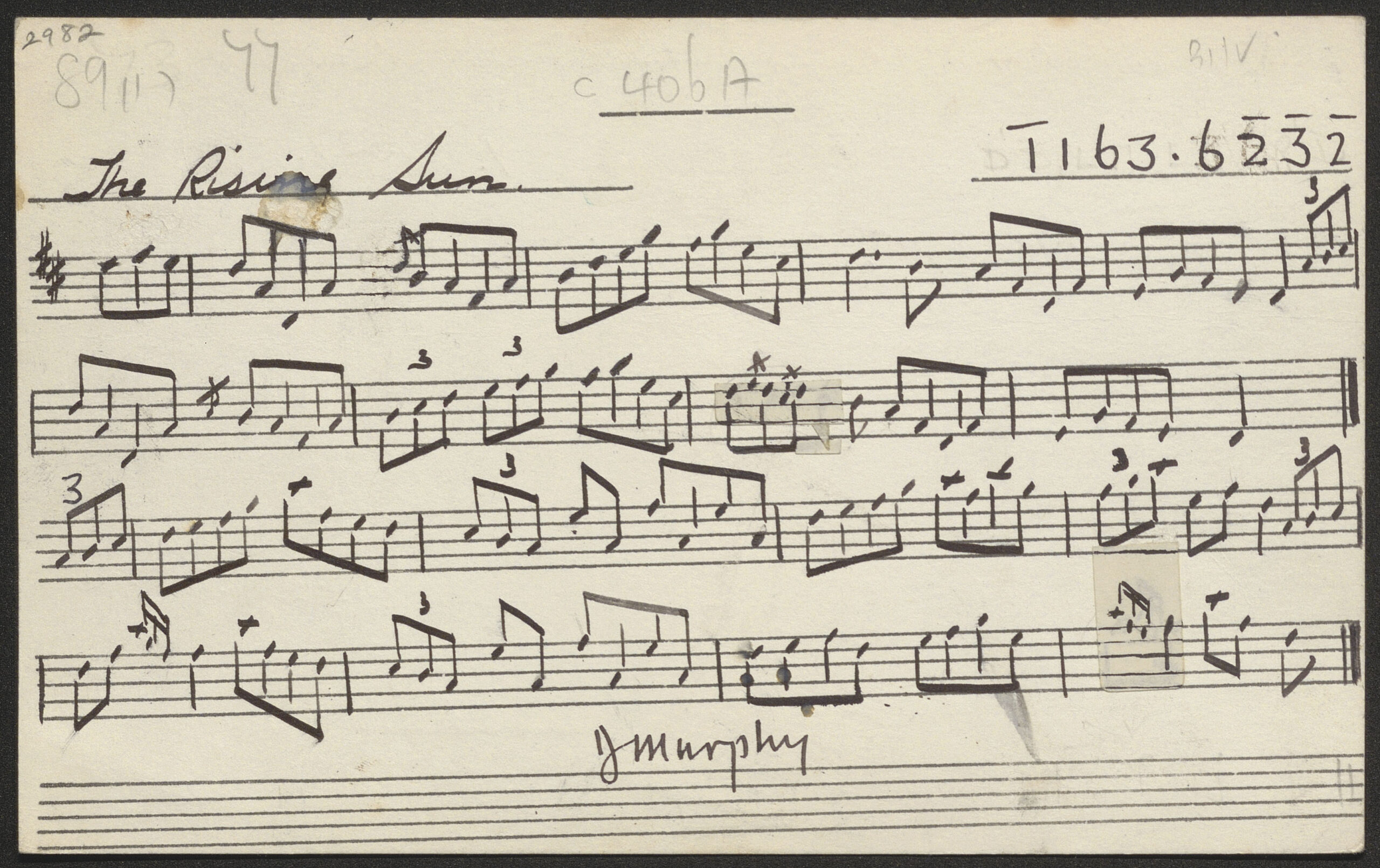
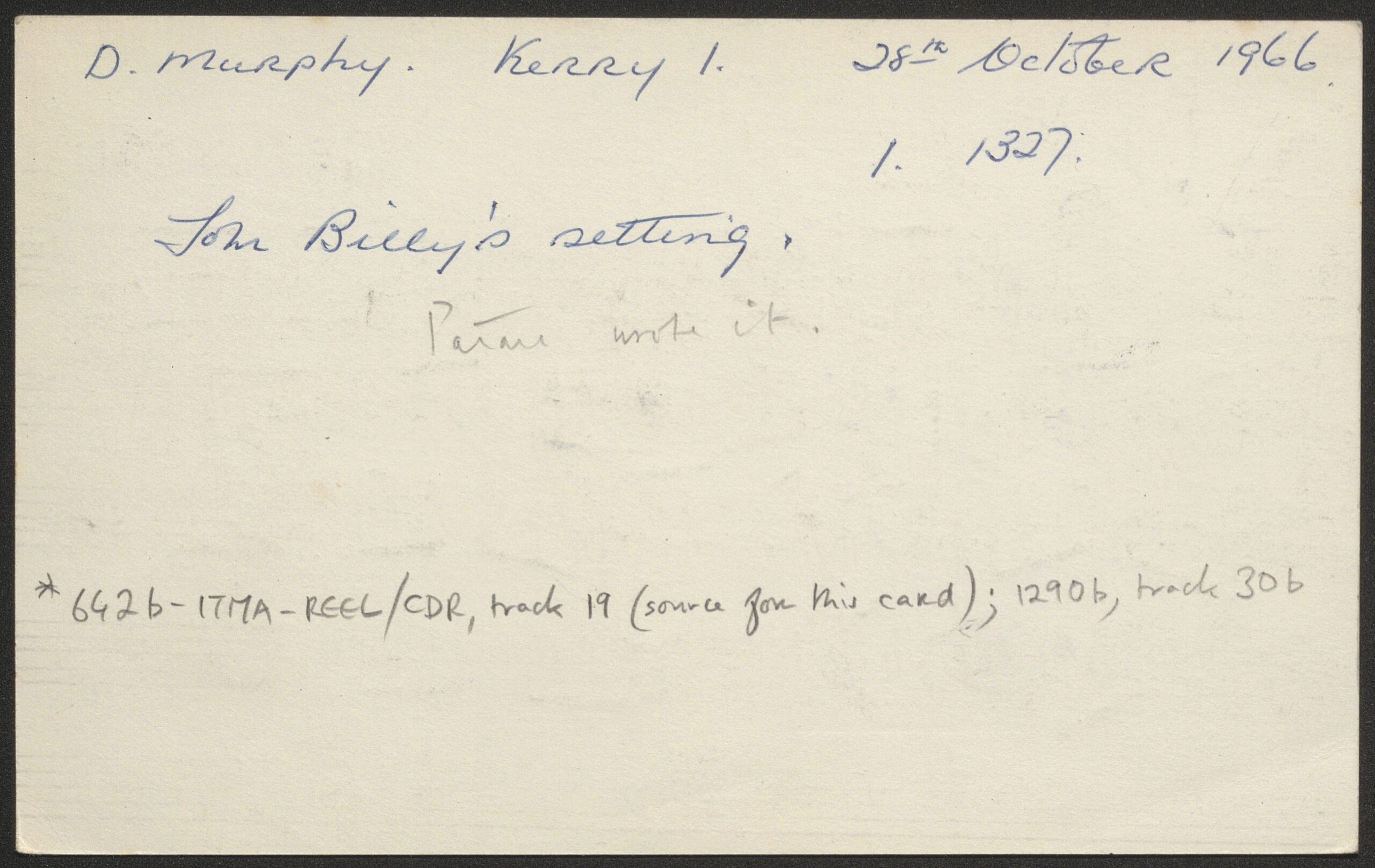
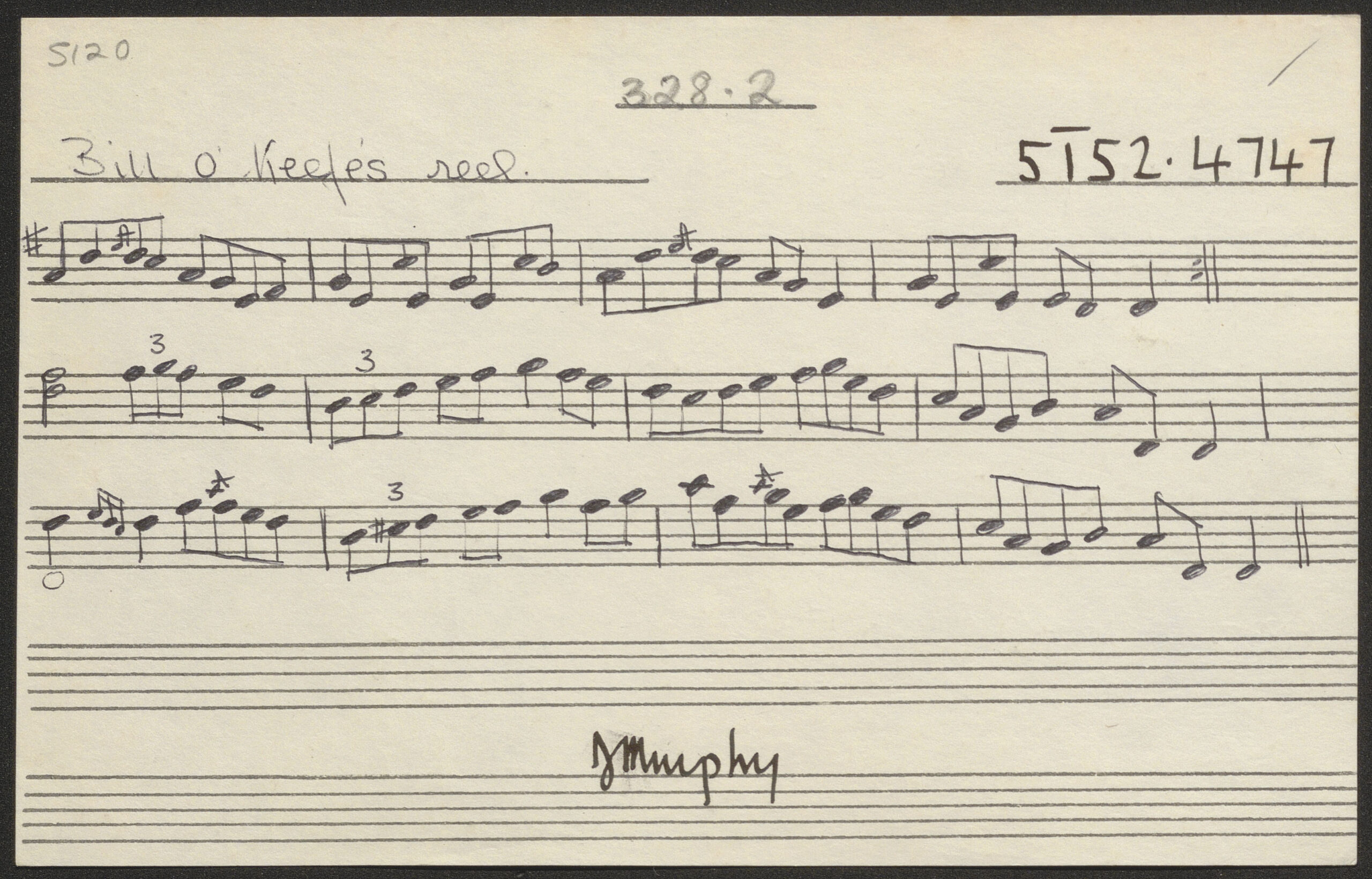
Denis Murphy also shared his special six-part version of Kiss the maid behind the barrel, which he played on several occasions over the years. Breathnach’s transcription of the reel from October 1966 takes up three cards (CICD 4871–4873). A new interactive transcription of this source recording made by Anton Zille can be found below.
Kiss the maid behind the barrel, reel / Denis Murphy, fiddle ; transcribed by Anton Zille. (Breandán Breathnach Collection. Reel-to-Reel 30, October 1966)
Denis Murphy named some of the tunes after places he associated them with. The Knocknaboul reel (CICD 5991) refers to a townland on the Kerry side of the Cork-Kerry border near Ballydesmond, Co. Cork; Denis and his sister Julia also called a set of popular polkas after this townland.
The Gneeveguilla reel (CICD 2844), or its original two-part version also known as The pride of Rathmore, refers to the East Kerry village close to Murphy’s birthplace. Spelled as “Gneeveguillia” on the card (as it is often pronounced) and officially called Gneevgullia, it was home to famous Irish musicians, poets and storytellers. Gneeveguilla is often referred to as the heart of Sliabh Luachra and this reputation is well-earned: historical records show that as many as 20 fiddle players lived there before the Great Famine.
Murphy’s own townland of Lisheen is featured in the name of a tune that sounds like a proto-version of Anything for John-Joe? – The Lisheen reel (CICD 4619; CRÉ 2, # 192). The place where Pádraig O’Keeffe lived, the Glountane Cross, appears in many tune titles as Glountane / Glentaun / Gleanntán etc., including the Glountane reel (CICD 3543; CRÉ 5, # 122) which is also known as Bridie’s joy.


A curious note on CICD 2844 saying “C nat[ural] better” reveals Breathnach’s struggle to faithfully reflect Denis Murphy’s version of the tune in his transcription of it. C natural notes that are relatively sharper than those of the 12-tone equal temperament scale were characteristic of Murphy’s and other local fiddle players’ intonation. Combined with tune variations that saw the performer alternate between C naturals and C sharps, this presented a real challenge to the collectors transcribing the music, meaning they had to pick between several modes that did not quite fit the version played. It is always interesting and sometimes enlightening to hear tunes such as The Gneeveguilla reel played by Denis Murphy himself – when contrasted with the modern recordings, his versions may strike one as noticeably more “modal”.
Another problem for the present-day researchers that perhaps was not considered as important in the early recording era is verifying whether a tune is someone’s original composition. The track notes of Kerry Fiddles (Topic Records, 12T309) famously featured a reel titled Muckross Abbey – a tune widely attributed to Charlie Mulvihill, who was Denis Murphy’s friend and one of chief musical partners during his periods of emigration in New York in 1949–1965. While this title controversy may be explained by an unintentional mix-up (the second reel in the set was indeed titled Mulvihill’s), determining whether such tunes are “traditional” or had a living 20th century composer is not an easy task.
Traditional musicians have not always been keen to reveal the authorship of their tunes for reasons ranging from modesty or insecurity to the desire of spreading their music further – believing that a tune would be more readily taken on without a composition label attached to it. If Charlie Mulvihill did write the tunes called after him, he certainly was not pushing his compositions too hard – it was his friends who shared them far and wide. Two tunes, a reel and a jig, are marked as Mulvihill’s own on the 1971 LP Sweet and Traditional Music of Ireland (Rego Irish Records, 1000) where he plays them. That includes Charlie Mulvihill’s reel recorded by others under such titles as Muckross Abbey, Murphy’s, O’Brien’s, Paddy Murphy’s wife and Mulvihill’s.
There was, however, another reel that Mulvihill frequently paired this tune with according to his son Tommy – and Breathnach recorded Murphy playing it in November 1967. Transcribed from Murphy on CICD 2706, this tune was later learned by Johnny O’Leary and eventually published as Charlie Mulvihill’s reel in Johnny O’Leary of Sliabh Luachra (no. 204). The same reel has also been recorded under the name of Lad O’Beirne’s. It is a fine example of tunes Murphy brought home from America.
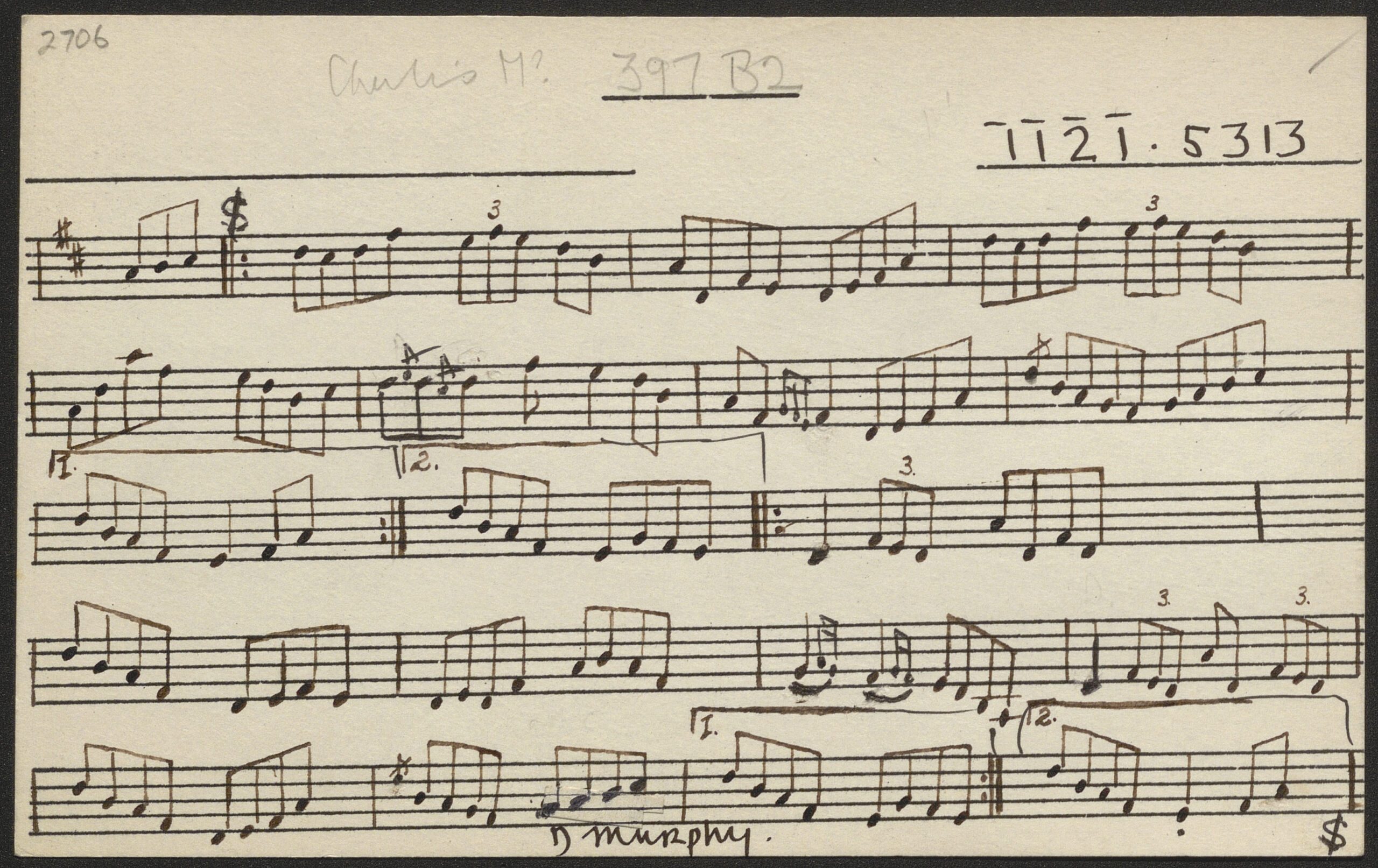
Additional research with the help of John Carty and Jesse Smith revealed that the same set of Charlie Mulvihill reels was also recorded by fiddlers Lad O’Beirne and Louis E. Quinn playing in duet. Both O’Beirne and Quinn had, however, played with Mulvihill, who was born in Manhattan in 1917 and was actively playing at New York house parties by early 1930s. Recordings of music played at such house parties can be found in the Charlie Mulvihill Collection at ITMA.
Unfortunately, Tommy Mulvihill could not confirm whether his father was indeed the composer of the reel transcribed on CICD 2706 – suggesting that these Charlie Mulvihill’s reels could have been attributed to Charlie by others – but the tune’s fascinating evolution could still be traced.
Denis Murphy played this D major reel to Breathnach with parts reversed, which was most likely accidental. With this in mind, the tune’s structure closely repeats that of another reel popularised by Willie Clancy under the name of Garret Barry’s reel, which is usually played in G major. This suggests that Charlie Mulvihill either learned an unusual version of the tune or worked to create a unique setting of his own, which he then passed on to other musicians like Denis Murphy.
Andrew Kuntz of the Traditional Tune Archive and Fiddler’s Companion goes a step further, citing Fr. John Quinn’s assessment that Garrett Barry’s reel is in fact a version of Miss McLeod’s / Mrs. MacLeod of Raasay, a Scottish tune that came from the Isle of Skye. Whether the latter is true or not, a curious intermediate version resembling both tunes, The grey plover, can be found in O’Neill’s 1001 / The Dance Music of Ireland (no. 759).
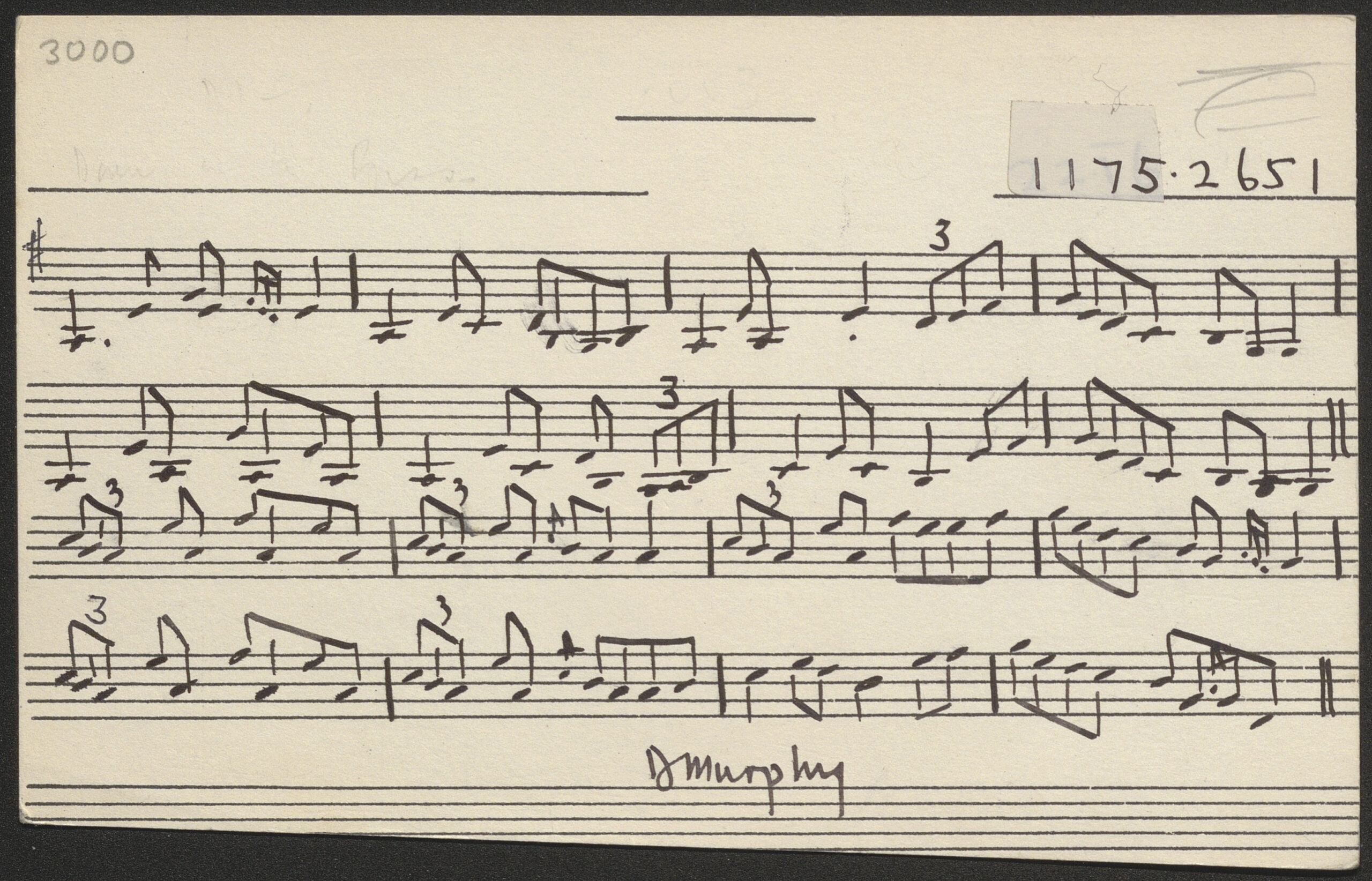
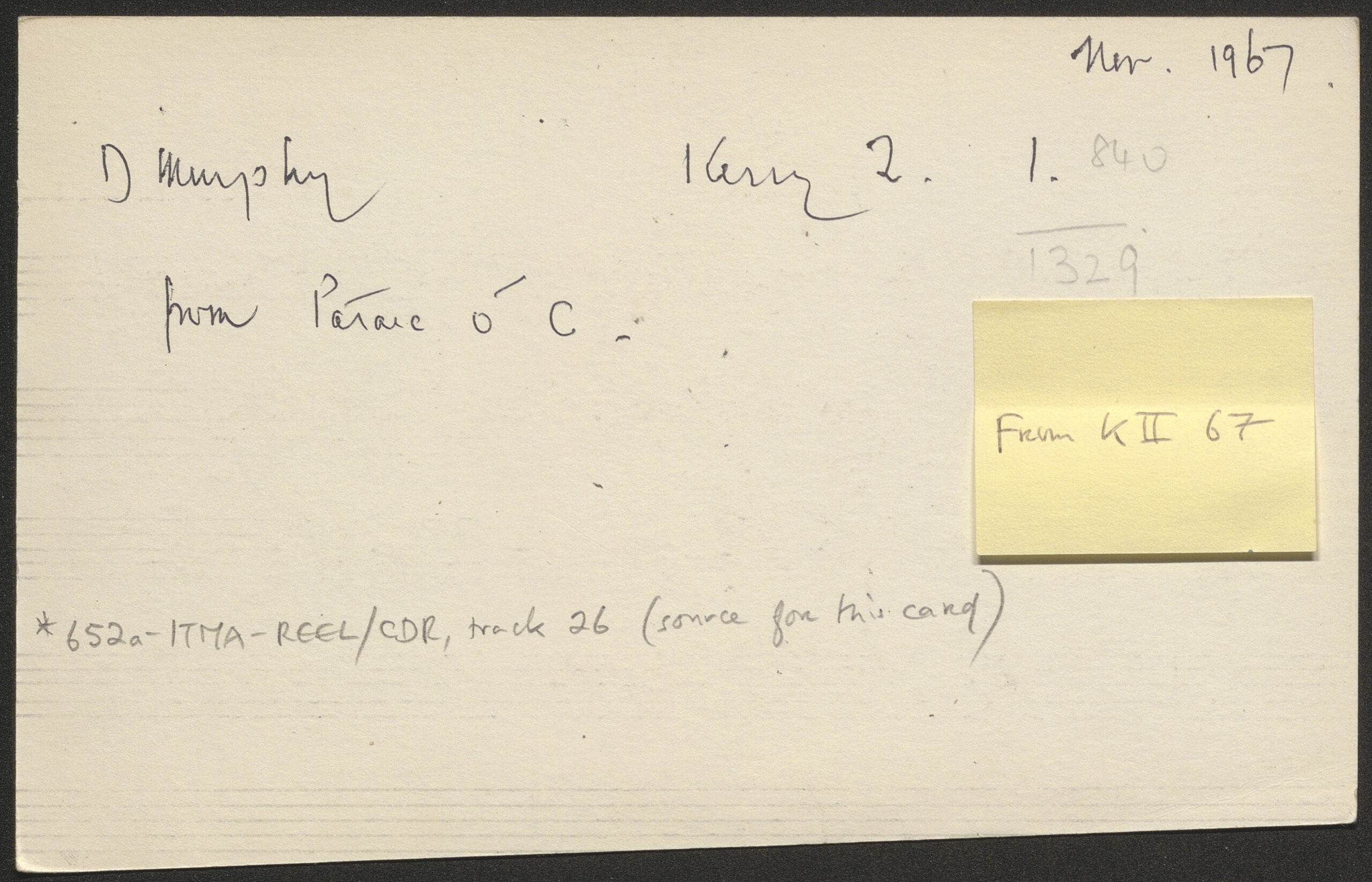
Scottish connections are not uncommon for reels played by fiddlers in Sliabh Luachra or North America – and some tunes ended up in the repertoire of both. An example of this is a fairly unexpected find among the reels Denis Murphy learned from Pádraig O’Keeffe. An untitled tune transcribed on CICD 3000 is King’s reel, presently considered to be a Cape Breton fiddle music standard.
Before becoming ubiquitous in Nova Scotia, this reel had been published under the titles of King’s and George the Fourth in several 19th century Scottish music collections. O’Keeffe may have picked it from one of these collections, another possible source being his uncle Cal O’Callaghan who had spent about 20 years in a predominantly Scottish community in Ohio. Breathnach suggested A dorian as the tune’s key in his transcription on CICD 3000 but the source recording made in November 1967 revealed additional accidentals, making Denis Murphy’s version of the reel slightly closer to the A mixolydian version commonly played today.
Another reel with a Scottish ancestry that Denis Murphy liked to play is the Glountane reel, also known as Bridie’s joy, which Murphy played for Breathnach in October 1966. Transcribed on CICD 3543 and published in Ceol Rince na hÉireann 5, no. 122 it closely resembles a strathspey called The Duke of Montrose.
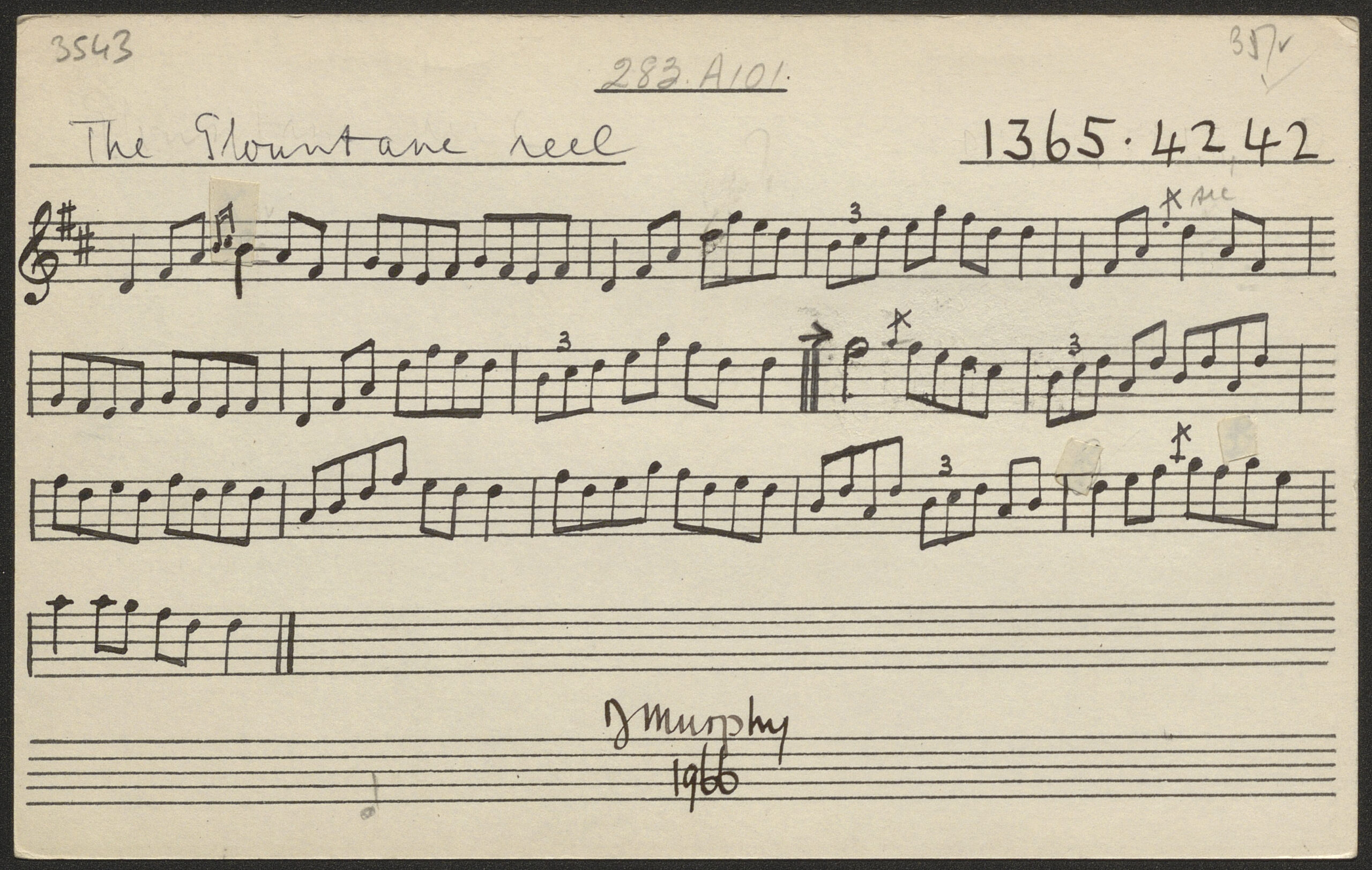
An even more apparent case of borrowing – and creative adaptation by Sliabh Luachra musicians – is The game cock reel (CICD 4312, CRÉ 5, # 158). In 1966 Breathnach collected it from fiddle player Jack O’Connell under the title Along the river banks; a year later he made a recording of Mollie Myers Murphy and Denis Murphy playing this reel in duet at Mollie Myers’ house in Glencollins, Co. Cork, which he used for his transcriptions. The tune had been published as a strathspey titled The game cock in various Scottish collections but perhaps the earliest of them was John Bowie’s A Collection of Strathspey Reels and Country Dances from 1789 where it is called Captain Francis Wemyss. Fast forward to the 20th century – and a three-part version of the same tune, with an extra part composed by accordion player Jackie Daly, became widely known at Irish music sessions under the name The bog carrot.
Scottish strathspeys were just some of the tunes imported to Sliabh Luachra to be adjusted to the local style of playing – Denis Murphy and Pádraig O’Keeffe were just as eager to reimagine some American music standards. Murphy famously recorded Turkey in the straw for the radio (published on Music from Sliabh Luachra, RTÉ 183 CD), which he played in an upbeat reel-like tempo. Murphy also popularised a specific reel version of Durang’s hornpipe which was later taken on by the likes of Patrick Street who recorded it under the title Dennis Murphy’s reel.
Durang’s hornpipe is an interesting case of a tune with a known composer evolving in traditional music over time. Written for the famed American dancer John Durang (1768–1821) by his violin teacher Mr. Hoffmaster in 1785 (according to Durang’s own memoirs) the tune’s original setting is quite different to some of those played by old-time musicians.
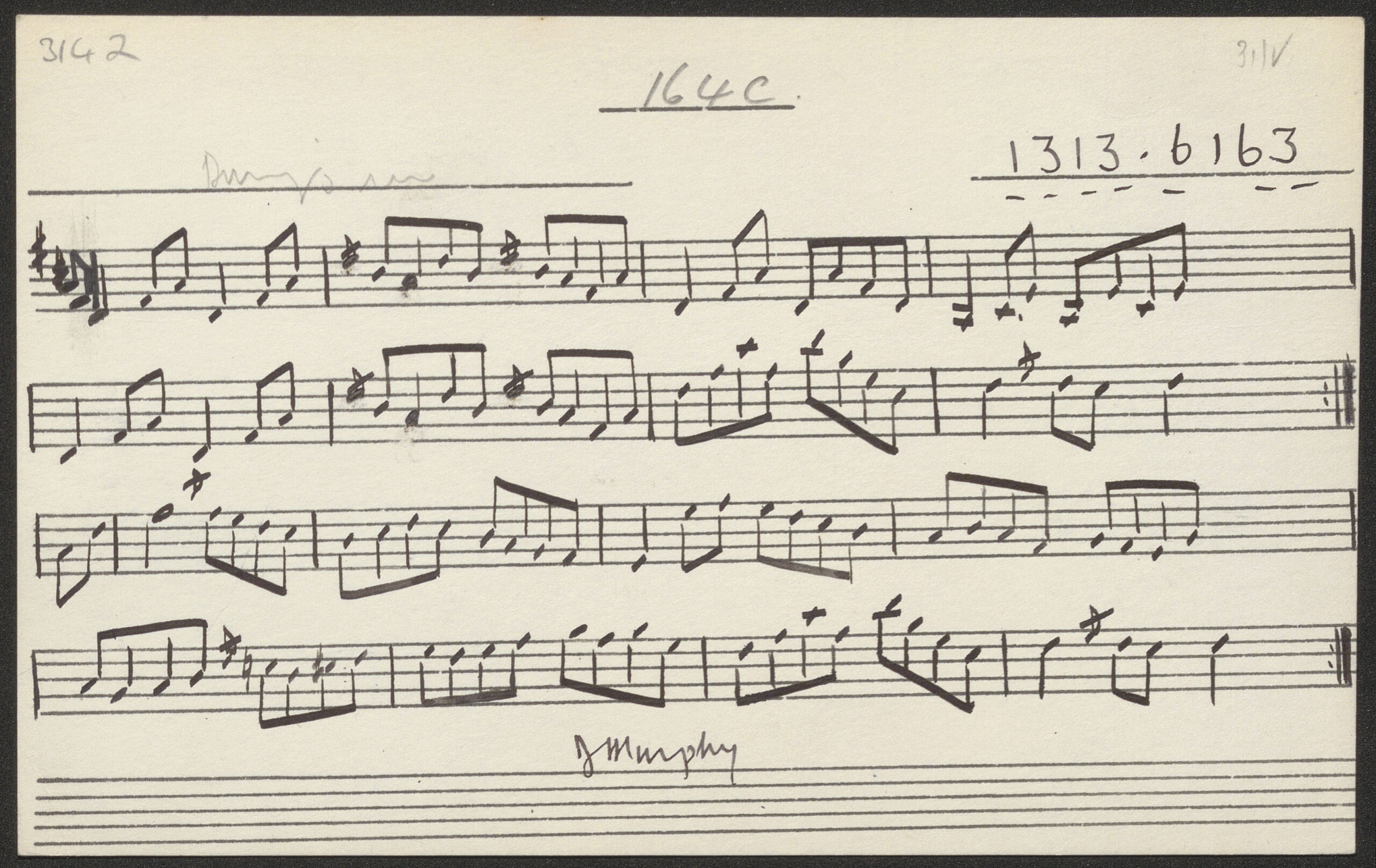
It is unknown whether Murphy picked up this tune in New York or if O’Keeffe had gotten to it earlier but the reel version now played in Sliabh Luachra sounds closer to the one played by a number of old-time and French-Canadian fiddlers – often performed in a lively reel-like tempo. Notably, it is also different from the settings published in Ryan’s Mammoth Collection and O’Neill’s 1001 / The Dance Music of Ireland.
Murphy played his version for Breathnach in October 1966 and, perhaps unsurprisingly, it was not selected for Ceol Rince na hÉireann. However, it was later collected from Murphy’s long-time musical partner Johnny O’Leary and published in Johnny O’Leary of Sliabh Luachra (no. 191). While the tune was never really a hornpipe in the Irish dance music sense of this word, editor Terry Moylan did clarify that “Durang’s seems to be considered, and used, as a reel in Sliabh Luachra.”
Not all of the tunes collected from Denis Murphy can be readily found in music collections – some are real riddles for the new generation of researchers and archive explorers to solve. Below are examples of two reels that until recently have not been recorded anywhere (at least not in these settings). I added some speculation on possible related tunes, which I determined to the best of my ability, to perhaps start a conversation on their origin.
An untitled reel transcribed on CICD 4273 was recorded by Breathnach twice. While the October 1966 recording is presented as a reel, Breathnach chose to notate the November 1967 take as a single jig / slide (CICD 1349). The confusion might be explained by the slow tempo of the 1967 recording but it also suggests that Murphy gave no additional information on the tune.
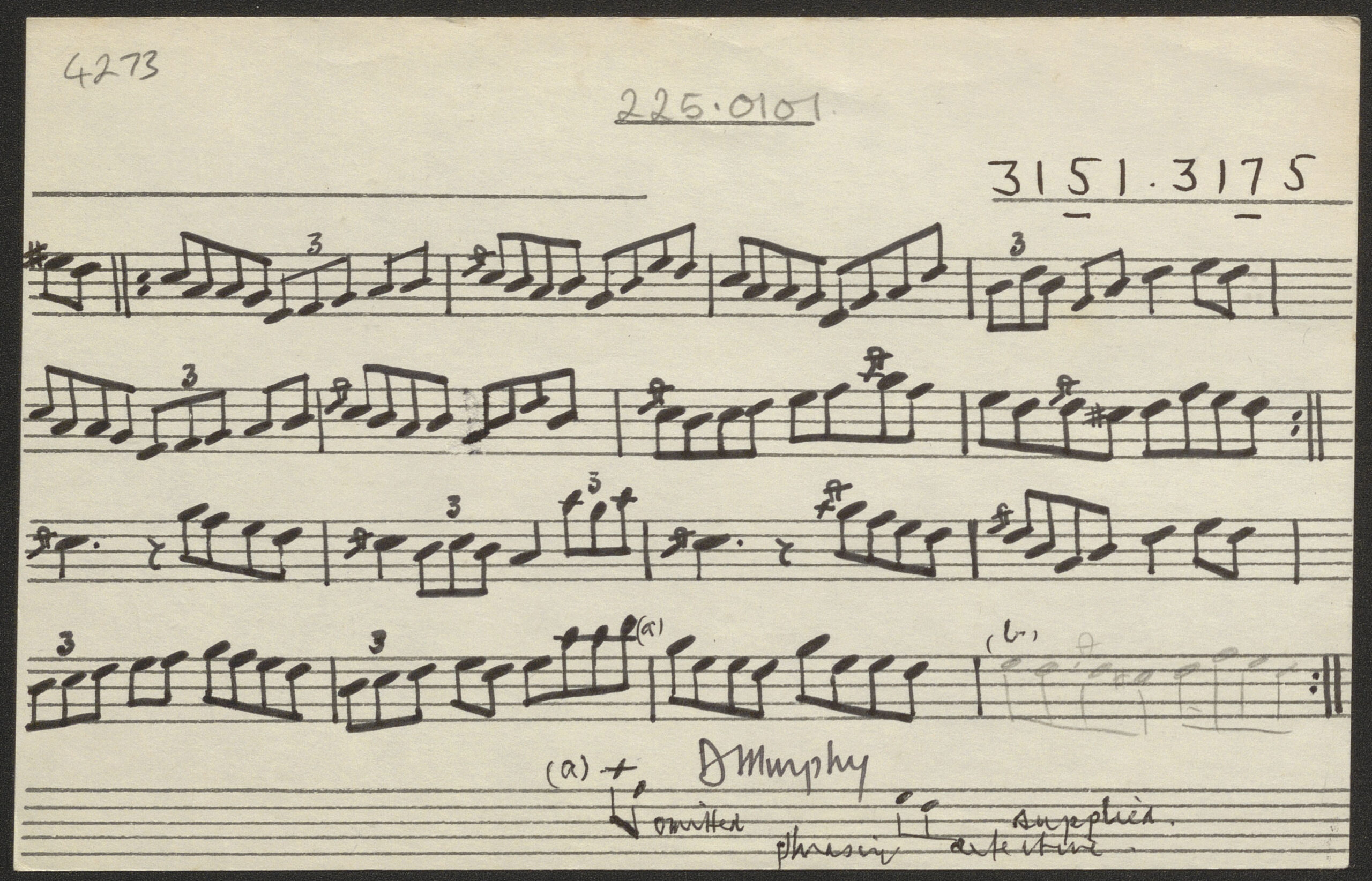
The only recorded sources for this tune to date include Where the bog is by Bryan O’Leary and Colm Guilfoyle (self-published, 2015), where it is titled Denis Murphy’s reel and a 2002 episode of the TG4 music documentary series Sé Mo Laoch, in which Caoimhín Ó Raghallaigh performs it as an unnamed tune.
Upon closer inspection, I found the tune to have a similar structure to the reel known as The Monaghan twig or Tinker’s apron (CRE 2, # 152) – except that Denis Murphy plays it in a minor key instead of mixolydian major. Murphy adds plenty of accidentals and embellishments to the tune, resulting in a very different feel from its suspected widely-known relative.
However, it is also possible that the tune had evolved directly from The Monaghan twig’s apparent Scottish ancestor, the strathspey Alasdair MacAlasdair (Alister McAlister). This would not be the first time this strathspey was reworked in Sliabh Luachra: a version found in Ryan’s Mammoth Collection under the title of Alistair MacAlastair might have served as a source for the polka now known as Denis Doody’s. This is a setting of The green cottage polka no. 1 that appears in the Polkas chapter of this project.
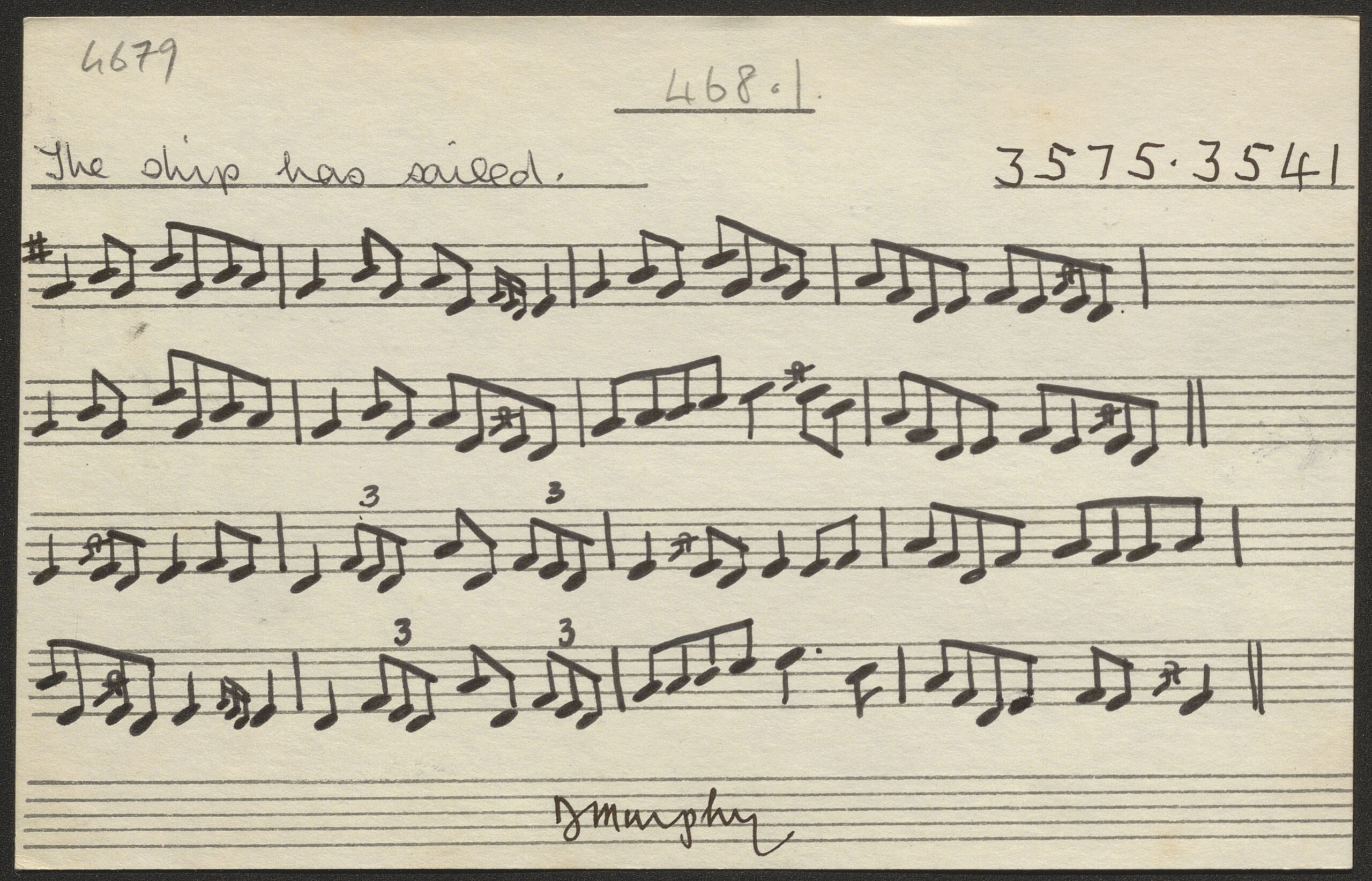
Another enigmatic reel was transcribed on CICD 4679 under the title The ship has sailed, which was provided by Denis Murphy himself. Murphy’s exchange with Breathnach was caught on tape and his jolly response points to the title being witty rather than book-accurate. I couldn’t find any music collection so far that would include this particular setting of the tune.
The boat parallel might, however, be quite fitting if we consider that the reel called Curragh races, also known as The maid in the cherry tree, closely resembles this tune if it were transposed to a higher key and had its parts reversed.
This mystery reel might be a perfect illustration of a Denis Murphy version of a tune: it may look simpler on paper but when played in the Sliabh Luachra style, the tune’s lyrical nature shines through and plenty of space is left for embellishments and variation. Meanwhile, the reversed parts and unexpected major mode in place of minor have all the hallmarks of a winking Denis Murphy telling a witty joke in a musical tongue.